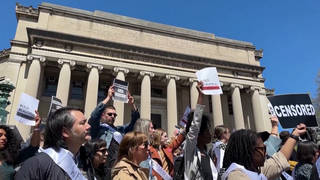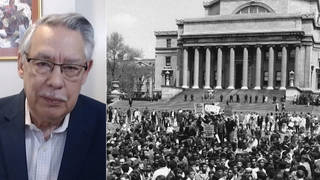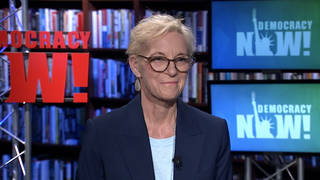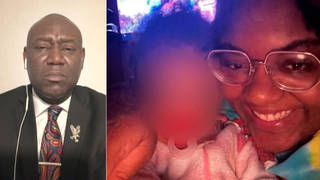
Related
Guests
- Dennis BanksNative American activist, leader and co-founder of the American Indian Movement.
Links
Thirty years ago, some 40,000 Native Americans and their supporters participated in a historic cross-country march called the Longest Walk to protest congressional legislation that would have abrogated treaties protecting Native American sovereignty. On Friday, thousands are expected to gather in Washington, D.C. after another five-month-long journey across the country to draw attention to the state of the environment and press for the protection of sacred Native American sites. We speak with the co-founder of the American Indian Movement, Dennis Banks. [includes rush transcript]
Transcript
JUAN GONZALEZ: Thirty years ago, some 40,000 Native Americans and their supporters participated in a historic cross-country march called “The Longest Walk.” They marched from San Francisco to Washington, D.C. to protest congressional legislation that would have abrogated treaties protecting Native American sovereignty. As a result, eleven bills were defeated, and the American Indian Religious Freedom Act of 1978 was passed.
This week marks the close of another cross-country march commemorating the original Longest Walk. Thousands are expected to gather in Washington, D.C. Friday after a five-month-long journey across the country to draw attention to the state of the environment and press for the protection of sacred Native American sites.
Starting out on February 11th of this year, participants walked, ran, camped and picked up piles of uncollected trash along two routes across the country, from Alcatraz to the nation’s capital. Along the way, they’ve compiled a list of demands from Native communities that will be delivered to Congressman John Conyers on Friday.
This is a sampling of some of the voices from the second Longest Walk.
DENNIS BANKS: The Longest Walk is an environmental walk. It’s also walking for issues of Native American interest, Native issues, the most important being sacred sites and the environment.
UNIDENTIFIED: We have protections for like the Liberty Bell, Statue of Liberty, Arlington National Cemetery. We don’t have an equal protection for sacred sites for indigenous people here in America. And that just seems a little bit unreasonable and unfair. Why would we have them for other things, but not for the people, the First Peoples of America?
WAYNE CRUE: My name is Wayne Crue. I’m a Shoshone-Bannock from Fort Hall, Idaho. I’m twenty years old. I’ve been walking since February 11th.
BONITA EAGLEFAWN LEONARD: My name is Bonita Eaglefawn Leonard, twenty-seven years old, Warm Springs, Wasco, Umatilla.
RANDY BLAKELY: My name’s Randy Blakely. I’m from San Francisco, Mission District, Fillmore District. I started February 11th on Alcatraz at the Sunrise Ceremony, and I’ll be going to Washington, D.C. As we cross each reservation, each piece of land that we go through, we hear the people’s struggles, each reservation that we go through. And I realize that that’s probably the most — that is the most important thing, that our biggest mission is to build this manifest so we can present Washington, D.C. with the struggles that are out there, that are still out there, and that some were even around in the ’78 walk, on the first walk.
WAYNE CRUE: The times are changing fast, and we have to adapt with them, so that’s what we’re trying to do on this walk, is to adapt with the changes that are going to happen.
BONITA EAGLEFAWN LEONARD: A lot of us weren’t grown with the traditions, you know, and don’t know the ceremonies, don’t know our own language. And, you know, a lot of us don’t care. Maybe we were born in the city, or maybe our parents lost it, because their parents lost it from boarding schools. And now, you know, I think it’s our opportunity to take it back and start learning our language, learning our songs and standing up with pride.
UNIDENTIFIED: This is a wake-up call to the people, and I’m determined to walk to Washington, no matter what. I’m sixty years old — or sixty years young.
OI WAKO: I’m from the northern island of Japan called Hokkaido, where a lot of indigenous peoples are still living. They are called Ainu. And I’m here for represent some of their culture, as well.
CALVIN MAGPIE: Most of the main things that I noticed that Native Americans are facing in Kansas is — it has to do with water, has to do with their water, has to do with, you know, where their water is coming from and how they’re using it, their water rights on the reservation. We’re worried about our children, worrying about our children being able to — you know, being able to play and, you know, go swimming, being able to drink water, being able to bathe in the water. You know, and we’re thinking about the next seven generations.
AMY GOODMAN: Some of the voices of those on the second Longest Walk. We’re joined now in Washington, D.C. by veteran Native American leader, co-founder of the American Indian Movement, Dennis Banks, one of the organizers of the Longest Walk.
Dennis Banks, welcome to Democracy Now! How does it feel to have arrived in Washington, D.C., having left San Francisco in the middle of February?
DENNIS BANKS: Well, the journey was absolutely great, and it just — you know, we made a lot of contacts, thousands and thousands of contacts with people, one-to-one, group sessions, about the environment and about the issues that we’re walking about. And it just feels absolutely great to be here.
AMY GOODMAN: Can you talk about why you embarked on this second walk, the first march thirty years ago, and why this one?
DENNIS BANKS: Thirty years ago, we were facing eleven bills, eleven pieces of legislation, which would have terminated our relationship with the federal government. It would have abrogated all of the treaties, and it would have took away our hunting rights, fishing rights, all the rights that we have on the reservation. And so, we walked across this country, 3,600 miles, and we collected 1,500,000 signatures along the way, and we presented that and other evidence, and we defeated — we had — all these bills were defeated.
And then, this year, about five years ago, when we started the preplanning of this, we noticed on our reservation the global warming effect, and we realized then that we would — that would be a major part of our walk. So — and it’s still raising some of the issues that face Native people. And so, this is an environmental walk first, and it’s also raising the issues, critical issues, that face us.
The protection of the sacred sites — for instance, thirty years ago, we asked for protective legislation for the San Francisco Peaks out in Arizona; thirty years later, nothing is ever done. And they continue to disrupt the ceremonies that at least twenty different tribes go to, go up there. All of these, protecting sacred sites like Sand Creek, the massacre that happened, Wounded Knee.
We’re asking for a great deal of protective legislation, because our graves are being trampled on. In 1990, we had over 1,200 graves dug up in Kentucky. And there’s a lot of states which it’s only a misdemeanor to disturb graves. But a lot of our bones are being kept in — you know, the artifacts and bones of our people are being kept in universities. University of California, Berkeley, they have 25,000 remains of our people, but many universities have that. So we’re asking that these universities — that Congress tap on the shoulders of these universities and say it’s time to put to rest the bones that you have in your boxes in your basements.
JUAN GONZALEZ: Dennis, can you talk to us about what you’ve seen from the ground, obviously, in this epic journey, the re-creation of the first one thirty years ago, in terms of the progress or lack of progress of Native American communities throughout the country? What’s changed in the past thirty years?
DENNIS BANKS: Well, for one thing, in the thirty years, a lot of gaming has come, because we were able to defeat these bills. A lot of gaming institutions have been constructed on reservations. So, because of that, we see a lot of new infrastructures being built up and a lot of new roads, new hospitals, clinics, things that we didn’t have before.
This walk, of course, has shown to us — we split the walk — as soon as we left San Francisco, we split it in two. The northern, which went straight across the States. And we took the southern route. We saw — we met a lot of indigenous people in the South, the southern route, and talked about the chromium seeping into the Colorado River, affecting the Fort Mojave tribes, the Walapai tribes, Havasupai, the Yavapai-Apache. And the exploratory drilling that’s going on now for uranium, more uranium mining on the Navajo reservations, they, the Navajo Nation, have taken a strong position against the uranium mining. But we saw — we saw not only the proposed buildings of new plants, but we met with the grandmothers, people my age — I’m seventy-five — people older, like eighty-year-old grandmothers, and we heard their stories firsthand. Some of them wept openly in telling us their stories about how they felt the contamination of the water was affecting the ceremonies, how the contamination of the air was affecting, you know, the breathing. So, the global warming is honest.
We also heard from other tribal people in Oklahoma about what gaming is doing. And there’s a lot of people who are concerned that the gaming is giving more power to the tribal councils, and they, in turn — some of them we saw, where there was actual misuse of their power in Oklahoma. But that’s also in other states: Minnesota and also in California, where there’s misuse of huge power, because they’ve got it from gaming. And community people aren’t allowed to sometimes speak up against this big — the new power that we have. That’s on the negative side.
On the positive side of gaming, as I said, we’re building more schools, more hospitals, more clinics. The infrastructure is being built up. We see a lot of new relationships between the counties and the states where we have big casinos. We now — in some places, we employ more non-Indians than we do Indian people, and that’s a good relationship that we have with a lot of the counties and states across the country.
But it’s also moved us into another arena, where Native people are becoming the players, because of the finances that we’re able to provide. We become courted. We become wined and dined. And they’re after not so much the Indian vote, because in some places we don’t — we’re not — there’s one percent of the vote across this country. But they’re after some of the big bucks. And when they do that, then of course there’s some trading going on, as in other arenas. When they come asking, we have to deal.
AMY GOODMAN: Dennis Banks, can you talk about the Longest Walk northern route going to the US penitentiary in Louisburg, Pennsylvania, and also the honoring of the Native American leader, Leonard Peltier, in jail for life?
DENNIS BANKS: We, of course — in 1978, we raised the issue of Peltier’s innocence and how he was, I felt, wrongly committed, convicted, on fabricated evidence. And just, to me, it was just innuendos.
And now — but, well, I want to say about the ’78 walk, again, just a little bit. The ’78 walk was — we were joined by many, many tribes, and then also from Japan came the Buddhist monks and nuns of Nipponzan Myohoji. And I want to say “Namu myoho renge” to them, because again they’re joining us, and we have approximately twenty-nine Japanese with us. And a lot of our people are learning to expand our horizon of people and culture worldwide. There’s people from Australia, Germany, France. We have a big diverse group of people.
But again, we went to — we stopped in — thirty years ago we went to the federal penitentiary in Kansas at Leavenworth. And now, we — our northern walk attempted to visit Leonard in Pennsylvania. Peltier, over thirty-two years — and I was in the courtroom sixteen years after he was convicted, when the government admitted, contrary to what they said in the closing arguments, that Peltier shot — picked up his rifle and shot the agents. They said he shot them, and then, sixteen years later, they admitted they did not know who shot those agents in South Dakota. And the judge, of course, I felt — he said, “What do you mean?” He said, “Sixteen years ago, you said Peltier shot those agents. And now you’re saying you don’t know who shot them.” We felt at that time that Peltier would be freed because of the error, but he still sits in prison.
And, of course, we still bring up his name. We still — we thought that maybe the prior president would have given clemency. We, of course, knew right away that — and it was struck down for a clemency hearing with President Bush, and so we know that that’s out of the picture. So we have to rely on the American people to stand with us on this one. They have stood. A lot of — we’ve collected — at that time, thirty years ago, we collected over —-
JUAN GONZALEZ: Dennis Banks, if I could just interrupt you, we have about a minute left. I wanted to ask you: you’re going to be meeting with John Conyers on Friday; what are you going to be presenting to him in terms of the key issues? We have about a minute left.
DENNIS BANKS: OK. We have a manifesto for change that we’ve been developing across the country. We’ll be representing that to Congressman John Conyers and other colleagues of his. This will be the first time that members of Congress have accepted from us a manifesto for change. They didn’t -— you know, they wouldn’t accept it, but we took it around thirty years ago. But this time, they’re accepting it, and we’re very grateful for that.
And I also want to thank General Motors, because they have donated for the use of this walk three vehicles. They’re hybrids. But they’ve helped us tremendously. All of — but the people across the country, the volunteers that helped us, tremendous volunteers, and I was going to rename the walk, Longest Walk, to the Longest Buffet, because of all the help they’ve given us.
AMY GOODMAN: Well, Dennis Banks, we thank you very much for being with us. We will link at democracynow.org to your website, the public events you’ll be involved with tomorrow. Dennis Banks, Native American leader, co-founder of the American Indian Movement, leader of the second Longest Walk. They have just arrived in Washington, D.C. from San Francisco, where they began in mid-February.










Media Options